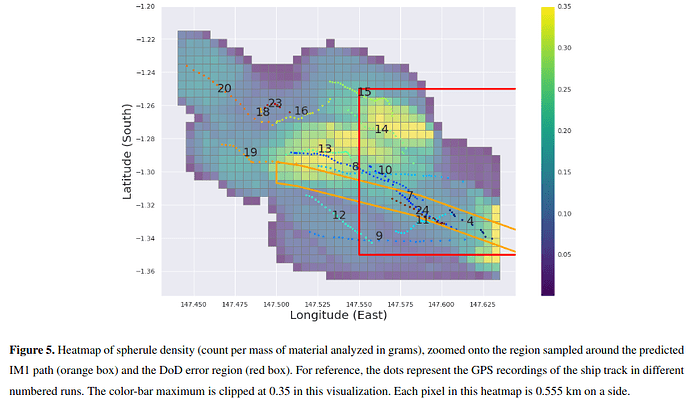I have posted here earlier about Harvard astronomer and Galileo Project founder Avi Loeb’s expedition to the South Pacific ocean off the coast of Papua New Guinea where, on 2014-01-08, a meteor believed to be of interstellar origin was predicted to have fallen.
- Avi Loeb—Hunting for an Interstellar Meteor on the Sea Floor off Papua New Guinea (2023-06-19)
- Avi Loeb—Metal Spherules Possibly from Interstellar Meteor Recovered (2023-07-13)
In the latter report, Prof. Loeb said that the recovered metal spherules believed to have come from the meteor were in the hands of three laboratories who were in the process of performing a variety of analyses to determine their composition and compare it to objects that originated in our solar system. These analyses have now been completed, and results posted on arXiv on 2023-08-29 in the preprint “Discovery of Spherules of Likely Extrasolar Composition in the Pacific Ocean Site of the CNEOS 2014-01-08 (IM1) Bolide” (full text at link). The results are…intriguing. Here is the abstract.
We have conducted an extensive towed-magnetic-sled survey during the period 14–28 June, 2023, over the seafloor centered around the calculated path of the bolide CNEOS 2014-01-08 (IM1) about 85 km north of Manus Island, Papua New Guinea. We found about 700 spherules of diameter 0.05–1.3 millimeters in our samples, of which 57 were analyzed so far. The spherules were significantly concentrated along the expected meteor path. Mass spectrometry of 47 spherules near the high-yield regions along IM1’s path reveals a distinct extra-solar abundance pattern for 5 of them, while background spherules have abundances consistent with a solar system origin. The unique spherules show an excess of Be, La and U, by up to three orders of magnitude relative to the solar system standard of CI chondrites. These “BeLaU”-type spherules, never seen before, also have very low refractory siderophile elements such as Re. Volatile elements, such as Mn, Zn, Pb, are depleted as expected from evaporation losses during a meteor’s airburst. In addition, the mass-dependent variations in ^{57}{\rm Fe}/^{54}{\rm Fe} and ^{56}{\rm Fe}/^{54}{\rm Fe} are also consistent with evaporative loss of the light isotopes during the spherules’ travel in the atmosphere. The “BeLaU” abundance pattern is not found in control regions outside of IM1’s path and does not match commonly manufactured alloys or natural meteorites in the solar system. This evidence points towards an association of “BeLaU”-type spherules with IM1, supporting its interstellar origin independently of the high velocity and unusual material strength implied from the CNEOS data. We suggest that the “BeLaU” abundance pattern could have originated from a highly differentiated magma ocean of a planet with an iron core outside the solar system or from more exotic sources.
The anomalous spherules were found mostly in areas along the predicted path of of the meteor, near the impact area. Dredging runs in control areas away from the path did not find such a density of spherules.
The elemental composition of the “BeLaU” spherules is weird.

On this chart, the relative abundance of chemical elements in spherule S21 is plotted in comparison to that of type CI chondrite meteors known to originate in our solar system, so that 1 indicates equal relative abundance, numbers greater than 1 an excess, and less than 1 a deficiency. The elements beryllium (Be), strontium (Sr), lanthanum (La), and the radioactive elements thorium (Th) and uranium (U) are all enhanced by factors between 100 and 1000 compared to solar system material.
The ratio of iron isotopes in the spherules (plotted in the last chart) falls outside the range observed in igneous rocks found on solar system bodies, all of which are within the blue box on the left chart, which is magnified in the right chart.
Conclusions from the analysis include:
Spherules with the “BeLaU" abundance pattern shown in Figs. 12-16 were found only along IM1’s path and not in control regions. The “BeLaU" elemental abundance pattern does not match terrestrial alloys, fallout from nuclear explosions (Wannier et al., 2019), magma ocean abundances of Earth, its Moon or Mars or other natural meteorites in the solar system. This supports the interstellar origin of IM1 independently of the measurement of its high speed, as reported in the CNEOS catalog (Siraj and Loeb, 2022a) and confirmed by the US Space Command.
The “BeLaU" abundance pattern suggests that IM1 may have originated from a highly differentiated crust of a planet with an iron core outside the solar system. In that case, IM1’s high speed of \sim60~{\rm km~s}^{−1} in the Local Standard of Rest of the Milky-Way galaxy (Siraj and Loeb, 2022a) and the extremely large number of similar objects per star, \sim 10^{23\pm 1}, inferred statistically for the population of natural interstellar objects it represents (cf. Fig. 3 in Siraj and Loeb (2022b)), are challenging to explain by common dynamical processes. The “BeLaU" overabundance of heavy elements could perhaps have instead originated from r-process enrichment and fragmentation of ejecta from core-collapse supernovae or neutron star mergers (Radice et al., 2018; Johnson, 2019; Siegel, 2022; Fujibayashi et al., 2023). However, the “BeLaU" pattern also displays s-process enrichment which must have a separate origin, such as Asymptotic Giant Branch (AGB) stars (Busso et al., 1999; Bisterzo et al., 2011; Karakas et al., 2012). Another possibility is that this unfamiliar abundance pattern may reflect an extraterrestrial technological origin. These interpretations will be considered critically along with additional results from spherule analysis in future publications.
Note the next to last sentence. Uranium, thorium, and beryllium, all of which were found extremely enhanced in the “BeLaU" spherules are, of course, key elements in nuclear technology which might be used for space probes.
Here is Avi Loeb’s popular description of the analysis of the spherules.


